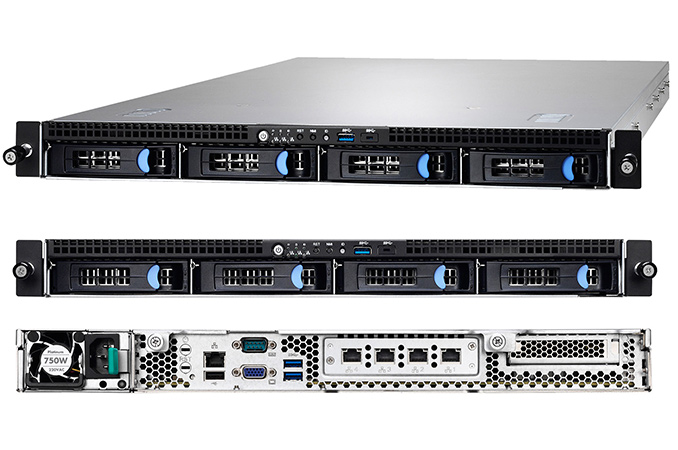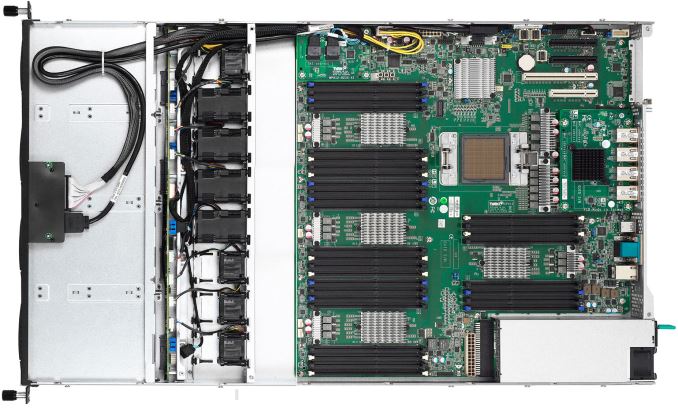Tyan Introduces 1U POWER8-Based Server for HPC, In-Memory Applications
by Anton Shilov on April 7, 2016 8:59 AM EST- Posted in
- IT Computing
- Enterprise
- IBM
- POWER
- Tyan
- POWER8

At this week's OpenPOWER Summit in San Jose, California, Tyan has introduced its new IBM POWER8-based 1U servers designed for high-performance computing (HPC) as well as in-memory applications. The new machines are designed to target niche markets that do not require extreme processing performance, but need a lot of RAM. The new Tyan GT75 expands the range of Tyan’s POWER8-based machines and helps IBM’s POWER8 platform to compete against Intel Xeon in niche markets.
Nowadays over 95% of servers are based on Intel’s Xeon microprocessors, which does not make producers of servers and operators of large datacenters happy because they have one supplier of key components that controls platform development and prices. Three years ago, IBM teamed up with Google, Mellanox, NVIDIA and Tyan to establish the OpenPOWER Foundation to develop servers based on IBM’s processors collaboratively. So far, IBM POWER-based servers have not gained a lot of market share, but it looks like they are starting to gain traction as companies like Tyan are expanding their POWER8 hardware offerings.
The Tyan GT75 machines (just like the Tyan TN71-BP012 servers launched a year ago) are based on one IBM POWER8 Turismo SCM processor with eight or ten cores and can be equipped with up to 1 TB of memory. The systems feature 32 R-DDR3L DIMM slots using four IBM Centaur memory buffer chips (MBCs) and support 32 GB modules, which are considerably more affordable than 64 GB or 128 GB memory sticks.
| Comparison of IBM POWER8 Turismo CPUs Compatible with Tyan's SC75 and TN71 Servers |
||||
| POWER8 8-Core | POWER8 10-Core | POWER8 12-Core | ||
| Core Count | 8 | 10 | 12 | |
| Threads | 64 | 80 | 96 | |
| Frequency (nominal) | 2.328 GHz 3.325 GHz |
2.095 GHz 2.926 GHz |
2.561 GHz | |
| L2 Cache | 512 KB per core 2 MB per CPU |
512 KB per core 5 MB per CPU |
512 KB per core 6 MB per CPU |
|
| L3 Cache | 8 MB eDRAM per core 64 MB per CPU |
8 MB eDRAM per core 80 MB per CPU |
8 MB eDRAM per core 96 MB per CPU |
|
| DRAM Interface | DDR3L-1600, memory connects to CPUs using the IBM Centaur MBCs | |||
| PCI Express | 3 × PCIe controllers, 32 lanes | |||
| TDP | 130W 190W |
130W 190W |
190W | |
While the GT75 servers (BSP012G75V4H) feature only one CPU, each IBM POWER8 core can process up to eight hardware threads simultaneously thanks to 16 execution pipelines. The chips also have massive caches (512 KB L2 per core, 8 MB eDRAM L3 per core as well as 16 MB per MBC), which are particularly useful for memory-intensive applications.
| Comparison of Tyan GT75 Servers | ||||
| BSP012G75V4H-B4C | BSP012G75V4H-Q4T | BSP012G75V4H-Q4F | ||
| CPU | IBM POWER8 8-Core 2.328 GHz 130 W/169 W TDP |
IBM POWER8 10-Core 2.095 GHz 130 W/169 W TDP |
IBM POWER8 10-Core 2.095 GHz 130 W/169 W TDP |
|
| Installed RAM | 8 × 16 GB R-DDR3L | 16 × 16 GB R-DDR3L | 32 × 16 GB R-DDR3L | |
| RAM (subsystem) | Up to 1 TB of DDR3L-1333 DRAM, 32 RDIMM modules, four IBM Centaur MBCs | |||
| Storage | 2 × 512 GB SSDs | 2 × 1 TB SSDs | 4 × 1 TB SSDs | |
| Tyan Storage Mezzanine | MP012-9235-4I (4-port SATA 6Gb/s IOC w/o RAID stack) |
|||
| LAN | 4 × GbE ports | 4 × 10 GbE ports | 4 × 10 GbE ports | |
| Tyan LAN Mezzanine | MP012-5719-4C Broadcom 1GbE LAN Mezz Card |
MP012-B840-4T Qlogic+Broadcom 10GbE LAN Mezz Card- |
MP012-Q840-4F Qlogic 10GbE LAN Mezz Card | |
The Tyan GT75-BP012, which is a 1U server that is designed for in-memory computing, HPC and virtualization, can be equipped with up to four 3.5” hot-swappable SAS 12G/SATA 6G HDD/SSDs, four network controllers (1 GbE and 10 GbE) as well as a 750 W PSU. The server uses the PLX PEX8748 PCIe switch and one PCIe 3.0 x8 expansion slot. Tyan did not reveal the price of the system, but said that it would be available already in April.
The new 1U machines complement the Tyan TN71-BP012 launched in March, 2015. The TN71 is a 1-way 2U platform for data analytics and applications, it supports 12 3.5” hot-swappable SAS 12G/SATA 6G HDD/SSDs, four 10 GbE network ports as well as two 1200 W PSUs for redundancy reason. This machine supports IBM POWER8 Turismo SCM processor with up to 12 cores and is generally more powerful than the GT75.
Source: Tyan











36 Comments
View All Comments
mattrock1988 - Friday, April 8, 2016 - link
Additionally, benchmarks can be cooked to favor one arch over another. I'd rather see performance in the real world to make any sort of determination before committing to one over the other.Vlad_Da_Great - Saturday, April 9, 2016 - link
@mattrock. We dont care about hegemony in the Enterprise. We care about cost, execution and reliability with great customer support. So, INTC so far has all that.close - Friday, April 8, 2016 - link
Oracle says Sparc is faster. Wonder why...Brutalizer - Friday, April 8, 2016 - link
Oracle says Sparc is faster, by posting hard numbers. Look at all the 25 ish benchmarks where SPARC M7 is 2-3x faster all the way up to 11x faster than POWER8. You can not cheat in offically reviewed benchmarks.satai - Sunday, April 10, 2016 - link
But you can easily choose a benchark you are going to publish...RISC is RISKY! - Tuesday, August 2, 2016 - link
I would support "Brutalizer". Every processor has its strength and weakness. If memory architecture is considered, for the same capacity, Intel is conjested memory, IBM is very distributed and Oracle-Sun is something in between. So Intel will always have memory B/W problem every way. IBM has memory efficiency problem. Oracle in theory doesn't have problem, but with 2 dimm per ch, that look like have problem. Oracle-Sun is for highly branched workload in the real world. Intel is for 1T/Core more of single threaded workloads and IBM is for mixed workloads with 2T-4T/Core priority. So supercomputing workloads will work fast on IBM now, compared to intel and sparc, while analytics and graph and other distributed will work faster on SPARC M7 and S7 (although S7 is resource limited). While for intel, a soft mix of applications and highly customized os is better. Leave the business decisions and the sales price. List prices are twice as much as sales price in the real world. These three processors (xeon e5v4, power8-9, sparc m7-s7) are thoroughly tuned for different work spaces with very little overlap. So there's no point in comparing them other than their specs. Its like comparing a falcon and a lion and a swordfish. Their environments are different even though all of them hunt. Thats in the real world. So benchmarks are not the real proof. We at the university of IITD have lots and lots of intel xeon e5v4, some P8 (10-15 single and dual sockets), and a very few (1-2 two socket M7 and 2 two socket S7). We run anything and every thing on any of these, we get our hands on. And this is the real world conclusion. So don't fight. Its a context centric supply of processors!colinstu - Thursday, April 7, 2016 - link
great if you need a bunch of ram in a system but don't need that many cores.F@st - Thursday, April 7, 2016 - link
Why POWER8 12-Core has 96 threads not 24 like Intel's?SlakeDK - Thursday, April 7, 2016 - link
I believe it is because Power8 has 8 threads or SMT - Simultaneous Multi-Threading. At least that is the case for the original IBM Power8 servers.name99 - Thursday, April 7, 2016 - link
Because it supports up to 8 threads per core. The primary technologies enabling this are:(a) the design is essentially clustered with two largely identical clusters. In single threaded mode, instructions can route to either cluster, but in 2, 4 or 8 threaded mode, 1, 2 or 4 threads are more or less pinned to a cluster.
(b) a 2-level register file design that allows for a massive pool of registers.
(c) much finer-grained control over thread performance priorities than Intel offers.
Intel's second thread get's about an extra 25% throughput.
IBM's second thread gets about an extra 45% throughput. At 4 threads this rises to about 90..95%, and at 8 threads to about 100%.
You can view this as IBM being better at getting performance out of a second thread, or as Intel at better at getting performance out of the first thread. Both are accurate, and represent each company's priorities.
But the bottom line is that for throughput, for most purposes, an Intel 20 core CPU is worth about 20*1.25=25 virtual cores; an IBM 12 core CPU is worth about 12*2=24 virtual cores.
Higher than 2-way SMT is common. Sun/Oracle offer 8-way SMT. Xeon Phi has a form of 4-way SMT. I think even some of the ARM CPUs designed specifically for high-performance networking are 4- or 8-way SMT, but I may be misremembering.